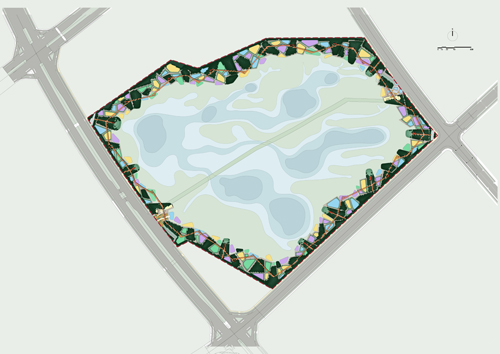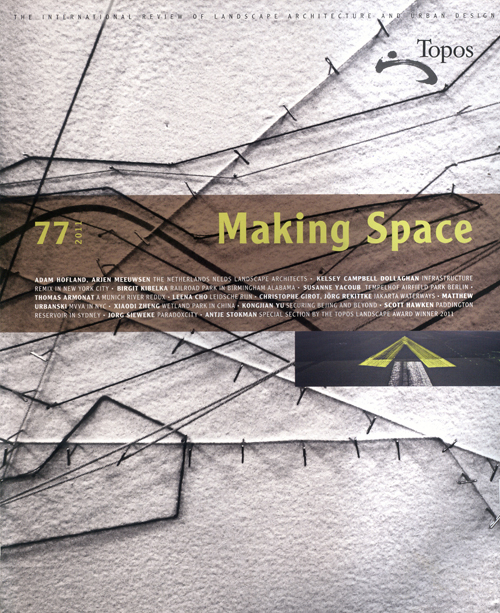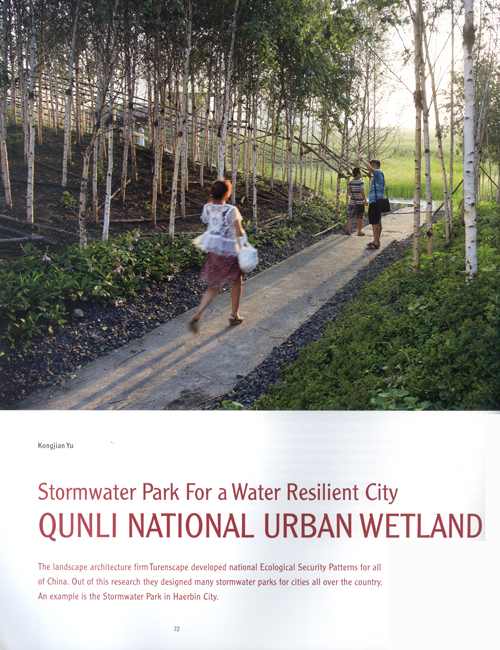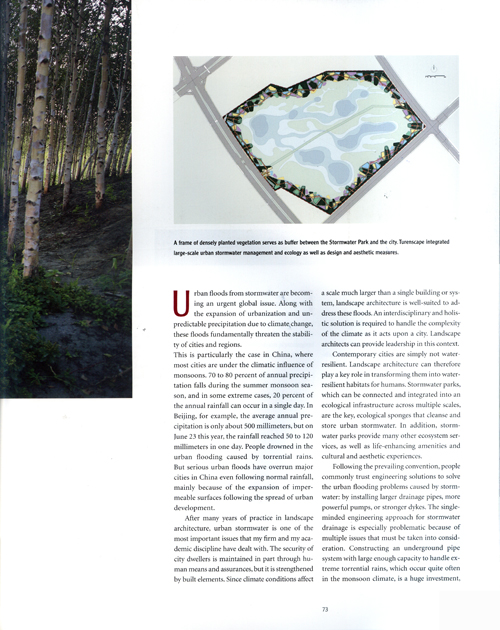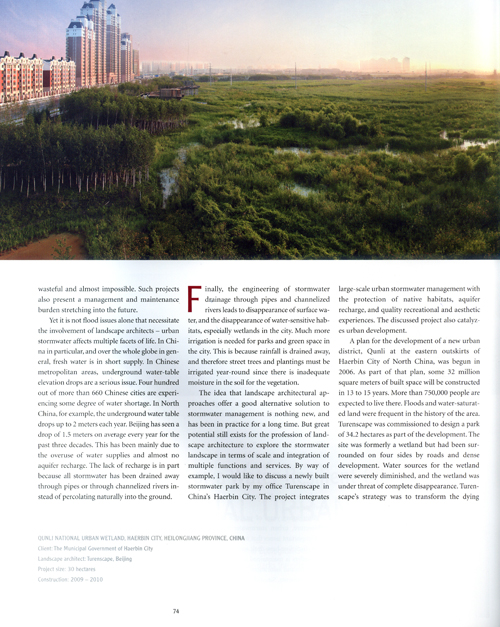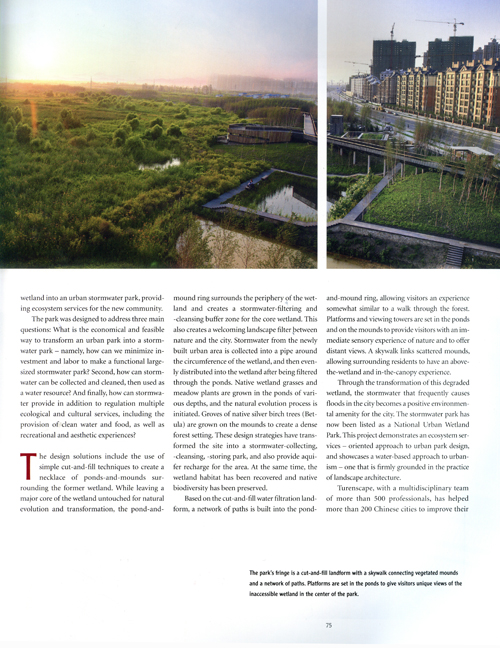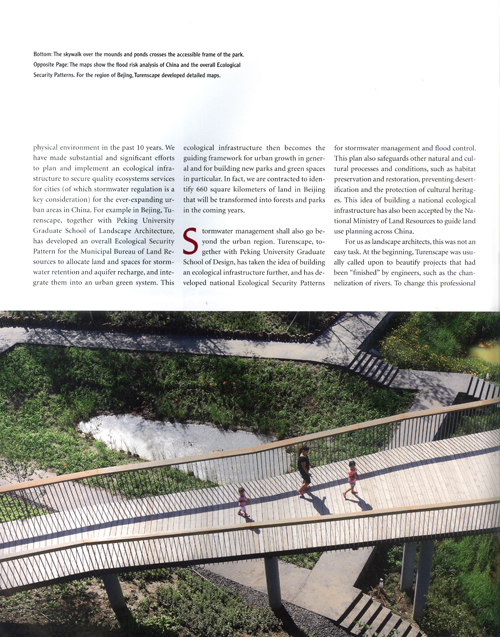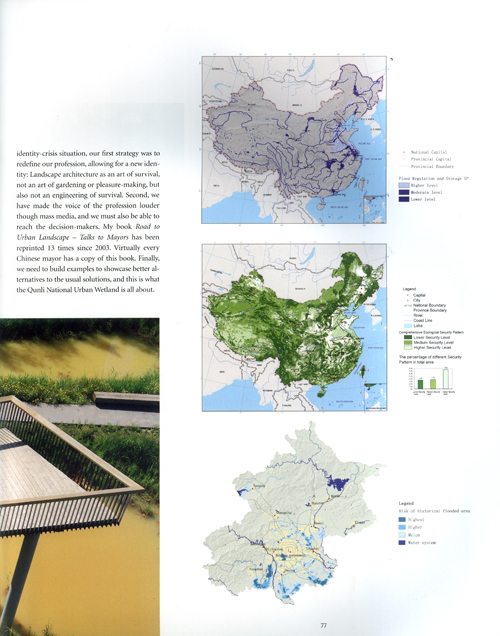文献来源:Kongjian Yu,Stormwater Park For a Water Resilient City[J].TOPOS,2011(77), Making Space:72-77
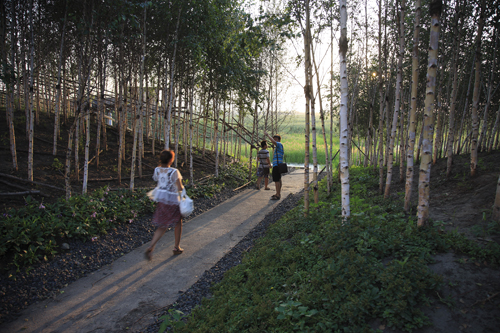
Urban floods from stormwater are becoming an urgent global issue.Along with the expansion of urbanization and unpredictable precipitation due to climate change, these floods fundamentally threaten the stability of cities and regions.
This is particularly the case in China, where most cities are under the climatic influence of monsoons.70 to 80 percent of annual precipitation falls during the summer monsoon season, and in some extreme cases, 20 percent of the annual rainfall can occur in a single day.In Beijing, for example, the average annual precipitation is only about 500 millimeters, but on June 23 this year, the rainfall reached 50 to 120 millimeters in one day.People drowned in the urban flooding caused by torrential rains.
But serious urban floods have overrun major cities in China even following normal rainfall, mainly because of the expansion of impermeable surfaces following the spread of urban development.
After many years of practice in landscape architecture, urban storm water is one of the most important issues that my firm and my academic discipline have dealt with.The security of city dwellers is maintained in part through human means and assurances, but it is strengthened by built elements.Since climate conditions affect a scale much larger than a single building or system, landscape architecture is well-suited to address these floods.An interdisciplinary and holistic solution is required to handle the complexity of the climate as it acts upon a city.Landscape architects can provide leadership in this context.
Contemporary cities are simply not water-resilient.Landscape architecture can therefore play a key role in transforming them into water-resilient habitats for humans.Stormwater parks, which can be connected and integrated into an ecological infrastructure across multiple scales, are the key, ecological sponges that cleanse and store urban stormwater. In addition, storm-water parks provide many other ecosystem services, as well as life-enhancing amenities and cultural and aesthetic experiences.
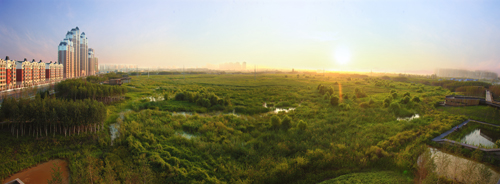
Following the prevailing convention, people commonly trust engineering solutions to solve the urban flooding problems caused by storm-water:by installing larger drainage pipes, more powerful pumps, or stronger dykes.The single-minded engineering approach for stormwater drainage is especially problematic because of multiple issues that must be taken into consideration.Constructing an underground pipe system with large enough capacity to handle extreme torrential rains, which occur quite often in the monsoon climate, is a huge investment, wasteful and almost impossible.Such projects also present a management and maintenance burden stretching into the future.
Yet it is not flood issues alone that necessitate the involvement of landscape architects-urban stormwater affects multiple facets of life.In China in particular, and over the whole globe in general, flesh water is in short supply.In Chinese metropolitan areas, underground water-table elevation drops are a serious issue.Four hundred out of more than 660 Chinese cities are experiencing some degree of water shortage.In North China, for example, the underground water table drops up to 2 meters each year.Beijing has seen a drop of 1.5 meters Oil average every year for thepast three decades.This has been mainly due to the overuse of water supplies and almost no acquire recharge.The lack of recharge is in part because all stormwater has been drained away through pipes OF through channelized rivers instead of percolating naturally into the ground.
Finally, the engineering of stormwater drainage through pipes and channelized rivers leads to disappearance of surface water, and the disappearance of water-sensitive habitats, especially wetlands in the city.Much more irrigation is needed for parks and green space in the city.This is because rainfall is drained away, and therefore street trees and plantings must be irrigated year round since there is inadequate moisture in the soil for the vegetation.
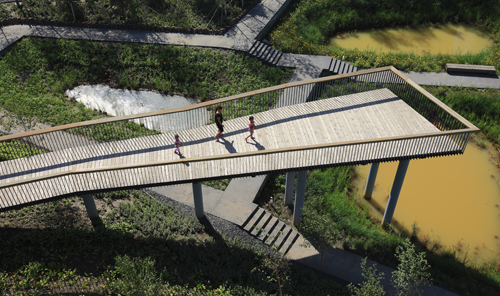
The idea that landscape architectural approaches offer a good alternative solution to stormwater management is nothing new, and has been in practice for a long time.But great potential still exists for the profession of landscape architecture to explore the stormwater landscape in terms of scale and integration of multiple functions and services.By way of example, i would like to discuss a newly built stormwater park by my office Turenscape in China’s Haerbin City.The project integrates large-scale urban stormwater management with the protection of native habitats, aquifer recharge, and quality recreational and aesthetic experiences.The discussed project also catalyzes urban development.
A plan for the development of a new urban district, Qunli at the eastern outskirts of Haerbin City of North China, was begun in 2006.As part of that plan, some 32 million square meters of built space will be constructed in 1 3 to 1 5 years.More than 750、000 people are expected to live there.Floods and water-saturated land were frequent in the history of the area.Turenscape was commissioned to design a park of 34.2 hectares as part of the development.The site was formerly a wetland but had been surrounded on four sides by roads and dense development.Water sources for the wetland were severely diminished, and the wetland was under threat of complete disappearance.Turenscape’s strategy was to transform the dying wetland into an urban stormwater park, providing ecosystem services for the new community.
The park was designed to address three main questions: What is the economical and feasible way to transform an urban park into a storm-water park-namely,how can we minimize investment and labor to make a functional large-sized stormwater park. Second, how can stormwater can be collected and cleaned, then used as a water resource? And finally, how can stormwater provide in addition to regulation multiple ecological and cultural services, including the provision of clean water and food, as welI as recreational and aesthetic experiences?
The design solutions include the use of simple cut-and-fill techniques to create a necklace of ponds•-and-mounds surrounding the former wetland.While leaving a major core of the wetland untouched for natural evolution and transformation, the pond-and-mound ring surrounds the periphery of the wet-land and creates a stormwater-fltering and-cleansing buffer zone for the core wetland.This also creates a welcoming landscape filter between nature and the city.Stormwater from the newly built urban area is collected into a pipe around the circumference of the wetland, and then evenly distributed into the wetland after being filtered through the ponds.Native wetland grasses and meadow plants are grown in the ponds of various depths, and the natural evolution process is initiated.Groves of native silver birch trees (Betula)are grown on the mounds to create a dense forest setting.These design strategies have trans-formed the site into a stormwater-collecting, -cleansing, -storing park, and also provide aquifer recharge for the area.At the same time, the wetland habitat has been recovered and native biodiversity has been preserved.
Based on the cut-and-fill water filtration landform, a network of paths is built into the pond-and-mound ring, allowing visitors all experience somewhat similar to a walk through the forest.Platforms and viewing towers are set in the ponds and on the mounds to provide visitors with all immediate sensory experience of nature and to offer distant views.A skywalk links scattered mounds, allowing surrounding residents to have all above-the-wetland and in-the-canopy experience.
Through the transformation of this degraded wetland, the stormwater that frequently causes
floods in the city becomes a positive environmental amenity for the city.The stormwater park has now been listed as a National Urban Wetland Park.This project demonstrates all ecosystem services-oriented approach to urban park design, and showcases a water--based approach to urbanism--one that is firmly grounded in the practice of landscape architecture.
Turenscape, with a multi disciplinary team of more than 500 professionals, has helped more than 200 Chinese cities to improve their physical environment in the past 10 years.We have made substantial and significant efforts to plan and implement an ecological infrastructure to secure quality ecosystems services forcities (of which stormwater regulation is a key consideration) for the ever-expanding urban areas ill China.For example in Bejing, Turenscape, together with Peking University Graduate School of Landscape Architecture, has developed an overall Ecological Security Pattern for the Municipal Bureau of Land Resources to allocate land and spaces for stormwater retention and aquifer recharge, and integrated them into an urban green system.This ecological infrastructure then becomes the guiding framework for urban growth in general and for building new parks and green spaces in particular.In fact, we are contracted to identify 660 square kilometers of land in Beijing that will be transformed into forests and parks in the coming years.Stormwater management shall also go beyond the urban region.Turenscape, together with Peking University Graduate School of Design, has taken the idea of building an ecological infrastructure further, and has developed national Ecological Security Patterns for stormwater management and flood control.
This plan also safeguards other natural and cultural processes and conditions, such as habitat
preservation and restoration, preventing desert inflation and the protection of cultural heritages.This idea of building a national ecological infrastructure has also been accepted by the National Ministry of Land Resources to guide land use planning across China.
For us as landscape architects, this was not an easy task.At the beginning, Turenscape was Usually called upon to beautify projects that had been ‘finished’ by engineers, such as the channelization of rivers.To change this professional identity-crisis situation, our first strategy was to redefine our profession, allowing for a new identity:Landscape architecture as an art of survival, not an art of gardening or pleasure-making, but also not an engineering of survival.Second, we have made the voice of the profession louder though mass media, and we must also be able to reach the decision-makers.My book Road to Urban Landscape-Talks to Mayors has been reprinted 1 3 times since 2003.Virtually every Chinese mayor has a copy of this book.Finally we need to build examples to showcase better alternatives to the usual solutions, and this is what the Qunli National Urban Wetland is all about.

